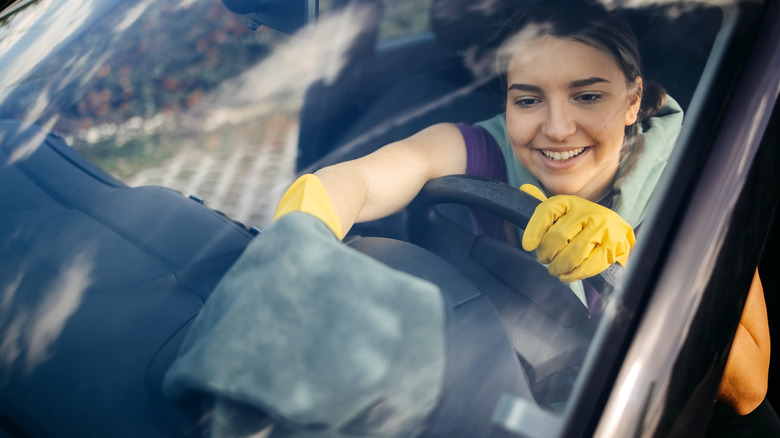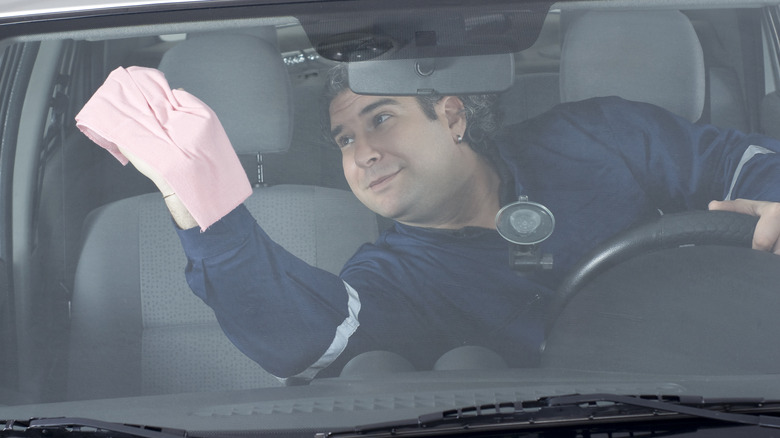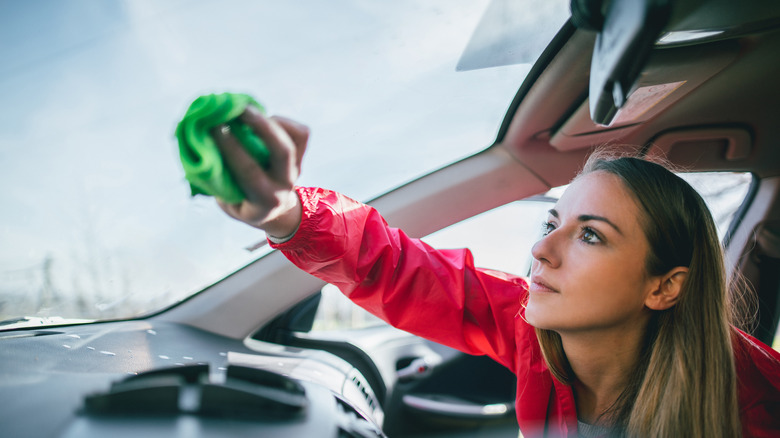How To Clean The Film From Your Car's Windshield (And Keep It Off)
Protecting your car's windshield isn't hard, and this can make a massive difference in shielding it from harm. And while there are many ways in which you can protect your windshield, one of the most overlooked is cleaning. After all, if your wipers are working perfectly, they'll effortlessly keep your windshield free from grime, dust, and water at all times. But (unfortunately), windshields are absolute magnets for smudges, dirt, smoke residue, and chemical vapor. That's why it's not unusual to find a windshield with a stubborn, greasy film clinging to the inside of the glass.
Cleaning the stubborn haze from your car's windshield might seem daunting. But once it's set in, your wipers won't do the trick, and a quick wipe with a cloth might make the smearing worse. On top of this, that foggy layer will cause severe glare, make night driving downright dangerous, and even reduce visibility. With that in mind, how do you remove the greasy film from your car's windshield — and more importantly, how do you keep it from popping back?
Before you get started, you'll need to gather some supplies. First, you'll want to make sure you have an automotive-safe cleaner — ideally, an ammonia-free glass cleaner to protect your window tint and dashboard. However, if you want to be a bit creative, a DIY mix of white vinegar and water (equal parts) will work just as well. You'll also want to bring along a few microfiber cloths and a bucket of warm, soapy water.
Cleaning the film from the inside of your windshield the right way
Now, before you start cleaning the inside of the windshield, it's best that you start with the outside. This way, you'll spot where the stubborn film is. Plus, it will make it easier for you to chase down streaks that are on the inside. Next, grab an ammonia-free glass cleaner or white vinegar and water mixture, and spray it directly onto the microfiber cloth. Do not spray the cleaning solution on the windshield. You don't want the solution to overspray on your dashboard and surrounding surfaces.
Next, grab the microfiber cloth and gently wipe the inside of your windscreen in circular overlapping motions to break up the foggy film. However, if there are any stubborn stains or spots, use a second pass with a 50/50 mix of isopropyl alcohol (a home staple that cleans your windshield wipers) and water. After cleaning, grab a dry microfiber cloth and wipe the glass clean to eradicate any remaining residue.
That said, you should avoid using any household glass cleaners, especially ammonia-based products, as they damage the tint film. Similarly, you should avoid abrasive materials like scrub pads and paper towels, as they will worsen the haze.
How to keep interior windshield film off for good
Dealing with a foggy windshield once is quite frustrating, but having it come repeatedly is even worse. Luckily, if you want to keep that stubborn film from forming again and again, there are a few practical yet simple steps you can take. To start with, you should know that heat plays a crucial role in accelerating the film buildup. It causes the dashboard and upholstery to release more volatile organic compounds (VOCs) that settle on the glass, creating the film. To reduce this, cover the windshield with a sunshade to minimize plastic off-gassing. You can also park your car in the shade or open the windows slightly to allow heat and gas to escape.
Next, avoid cleaning your dashboard and the windscreen with ammonia-based cleaners. Over time, they will vaporize and deposit a fresh layer of residue on the windshield. Instead, stick to alcohol-based or silicone-free products. They will clean and protect the interior surfaces without contributing to a foggy windshield. You'll also want to wipe the windscreen regularly with a dry microfiber. This will help clear the film before it builds up.
Also, remember that the cabin air filters play a crucial role, not just in trapping dust and improving air quality, but also in keeping your windshield clean. After all, old and clogged air filters will release dust, pollutants, and other particles that will eventually stick to your glass. So, to avoid this, replace the car's cabin air filters every 12,000 to 15,000 miles to maintain better air quality and to protect your windshield. And while at it, avoid smoking in your vehicle. Tobacco creates a stubborn, sticky residue that's tough to wipe away.


